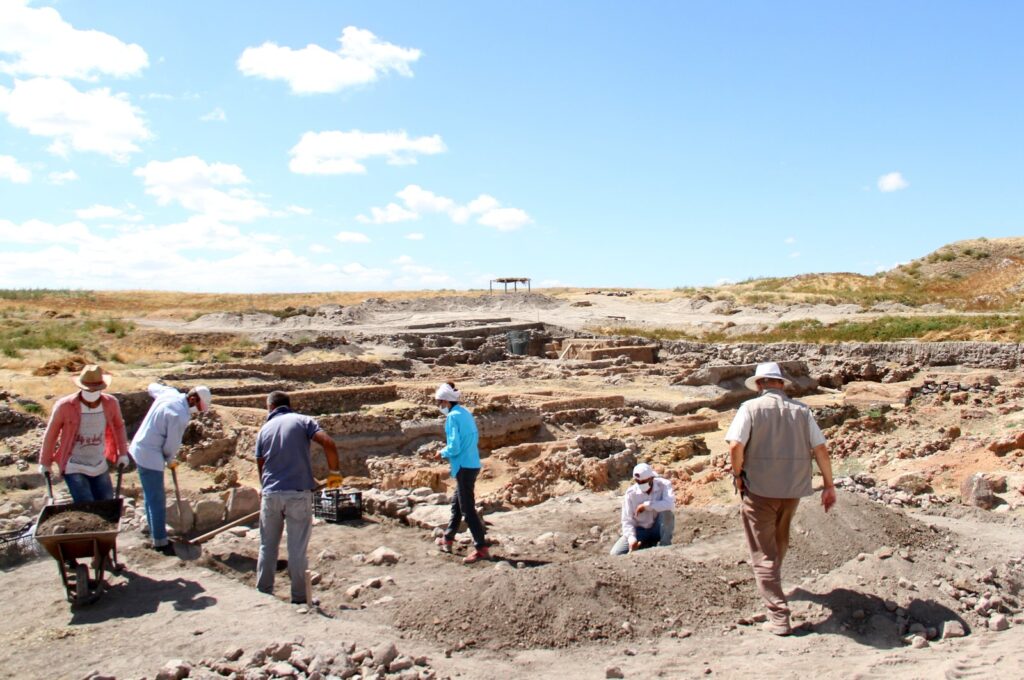4,300-Year-Old Figurines Unearthed in Central Anatolia
Hurriyet Daily News reports that a team of researchers led by Fikri Kulakoğlu of Ankara University uncovered more than a dozen 4,300-year-old figurines thought to depict gods and goddesses at the Kültepe mound in central Anatolia. Previous excavation at the site uncovered 35 similar figurines in one room of the same building.
Due to its ashy soil that is some 25 kilometres from the city centre of Kayseri and has continued ever since excavations began 72 years ago in the region called “Kültepe.”
This year, statues of God and Goddess from 4,300 years of age, assumed by Anatolians, were found during the excavations. The figurines will be on display in the temporary exhibition at the Kayseri Museum.


Ankara University Faculty of Language and History-Geography member and the head of Kültepe excavations, Professor Fikri Kulakoğlu, told the state-run Anadolu Agency that one of the two tablets taken out of Kültepe in the late 1800s and sold to an antique shop in Istanbul had gone to the British Museum and the other to the Louvre Museum.
Stating that scientists, who were curious about the city mentioned in the tablets, came to Turkey but could not find any tablets, Kulakoğlu said: “There was a Czech scientist named Bedrich Hrozny.
This scientist is the first person in the world to solve the Hittite language. This person came to Kültepe in Kayseri to find out where the city of Kaniş mentioned on the tablets is.
He destroyed one-third of the palace that we call ‘Warşama Palace.’ He dug a hole like a crater according to the excavation techniques of that time.”
“He was disappointed that he could not find a tablet. He drew the attention of his coachman, who asked, ‘What happened to my master?’ He answered that he could not find a tablet.
The coachman said, ‘You dug the wrong place, the tablets are not there, but in Mehmet Ağa’s field.’ He went back and started excavations in the place we call Karum, but he could not find many tablets,” he added.
“Meanwhile, there was an epidemic of malaria in the region. Hrozny, who was a former soldier, brought a quinine tablet against malaria with him. People came to him because of the epidemic, they wanted medicine.
He gave them a quinine tablet in return for a cuneiform tablet. Thus, he collected tablets from the villagers. Thanks to the tablets that he collected, which proved that Kültepe was the city of ‘Kaniş’ mentioned in the first tablets.
He took the tablets to his country and returned them to Turkey in 1936. The tablets in the Istanbul Archeology Museum are the ones he studied and returned later,” the professor said.
Kulakoğlu stated that they have been looking for an answer to the question, “What was Anatolia like in the Ancient Bronze Age, the period before the Assyrian merchants came to Anatolia?” since 2009, and said that they have continued excavations in the area of Kaniş, which is called the “upper city.”
Reminding that they found 35 god and goddess figurines collectively in the excavations carried out in the room of a building in 2017, Kulakoğlu said: “We found 15 more idols [statuettes] this year. Excavations continue in this area.
The building we excavated is probably an official, religious, a very large and unique place in Anatolia. The idols extracted from here are the works that depict the beliefs of the Anatolian people and the beings they worshipped 4,500 years ago.”
“Some of them are sitting on the throne and some are made schematically. These are works that are not available anywhere but Kültepe. You find a work worshipped by a person 4,500 years ago and bring it to light; this is exciting.”
He added that they were planning to exhibit them at the Kayseri Museum with a temporary exhibition.





